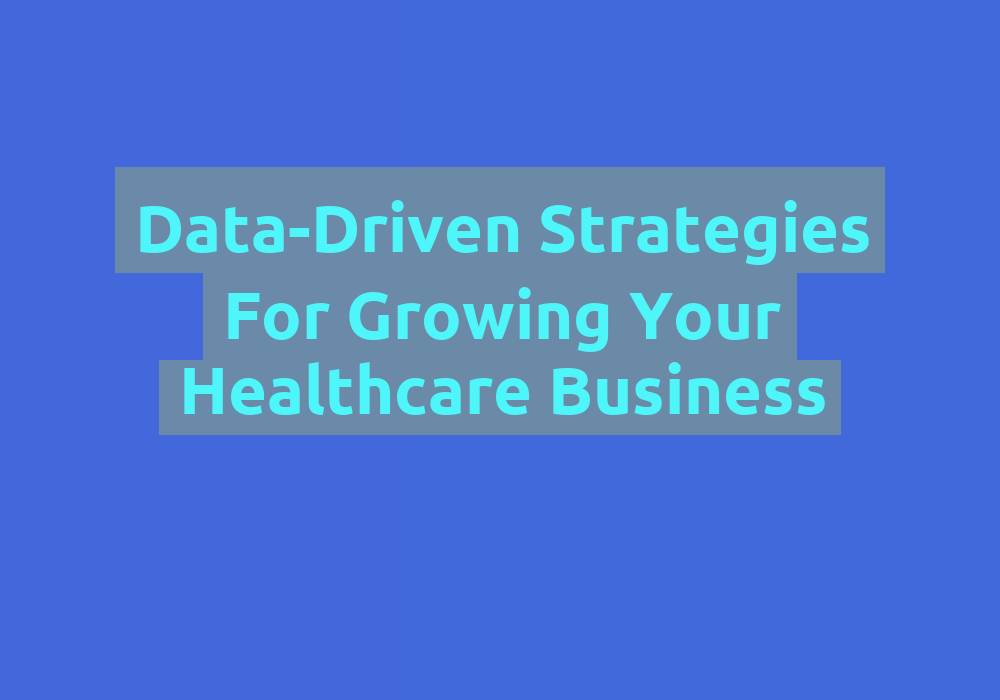Scale Your Healthcare Business in 2025 with Effective Strategies

Maximising Efficiency Through Advanced Technology in Healthcare
Technological advancements are dramatically reshaping the healthcare landscape, offering remarkable opportunities to enhance both operational efficiency and patient care. Understanding how to scale your healthcare business in 2025 involves leveraging these innovative tools, which can significantly streamline processes and improve patient outcomes across the UK. By embracing cutting-edge technologies, healthcare organisations can position themselves as leaders in the industry, ultimately benefiting patients and enhancing service delivery.
Adopting Electronic Health Records (EHRs) for Modern Patient Management

The implementation of Electronic Health Records (EHRs) is crucial for modernising the management of patient data within the NHS framework. These digital systems enable the effortless exchange of information among healthcare providers, improving care coordination and decreasing the likelihood of errors. The integration of EHRs facilitates real-time access to vital patient information, including medical histories, medication lists, and treatment plans, empowering clinicians to make informed decisions swiftly and effectively.
In the UK, the adoption of EHRs has been gradual but is gaining momentum as healthcare providers increasingly recognise their benefits. Trusts that have implemented EHRs report notable increases in efficiency regarding administrative tasks, allowing medical professionals to allocate more time to direct patient care. Furthermore, EHR systems can be customised to cater to the unique requirements of various healthcare settings, such as general practice, hospitals, and specialised clinics, enhancing their usability and effectiveness.
Additionally, EHRs play a vital role in supporting the UK’s commitment to delivering personalised healthcare. By harnessing data analytics, healthcare providers can identify trends, refine treatment protocols, and bolster preventive care measures. The long-term vision of NHS Digital aims for every patient to have an integrated health record by 2025, making EHRs a fundamental component of strategic planning for healthcare businesses seeking to expand their reach and improve service delivery.
Expanding Telehealth Services to Enhance Patient Access
The expansion of telehealth services is a critical strategy for reaching patients across the UK. The COVID-19 pandemic has underscored the importance of remote healthcare, and healthcare businesses must seize this opportunity to enhance accessibility and reduce waiting times. Telehealth effectively bridges geographical barriers, ensuring that patients in rural or underserved areas receive timely consultations and support tailored to their needs.
Innovative telehealth solutions encompass a variety of services, including virtual consultations, remote monitoring devices, and online health assessments. For instance, practices in Wales have successfully implemented telehealth services, enabling GPs to conduct consultations via video calls. This approach has significantly decreased patient footfall and optimised appointment schedules, demonstrating the effectiveness of telehealth in improving patient satisfaction while simultaneously reducing operational costs associated with in-person visits.
Moreover, telehealth can be seamlessly integrated with EHRs, enhancing the overall management of patient information. When patients engage in remote consultations, their data can be instantly updated in their health records, ensuring continuity of care. As the UK continues to adopt digital health solutions, scaling telehealth services will be pivotal in achieving the healthcare objectives set for 2025, ultimately improving outcomes for patients across the nation.
Harnessing AI and Data Analytics for Enhanced Care
The incorporation of Artificial Intelligence (AI) and data analytics is revolutionising healthcare by offering advanced tools for diagnostics and personalised treatment plans. The use of AI can significantly enhance clinical decision-making processes and improve patient outcomes. For instance, predictive analytics can identify at-risk patients by analysing vast datasets, including demographics, medical histories, and lifestyle factors, thereby enabling proactive interventions and tailored care.
In the UK, numerous hospitals are already employing AI algorithms to detect diseases, such as cancer, at much earlier stages, significantly improving survival rates. By deploying AI tools in diagnostics and treatment recommendations, healthcare providers can offer personalised therapies that cater specifically to the unique needs of their patients. This level of customised care is essential for scaling healthcare businesses, as it fosters patient engagement and trust, both of which are critical for long-term success.
Moreover, data analytics can optimise operational efficiency within healthcare organisations by identifying process bottlenecks and challenges related to resource allocation. By thoroughly analysing workflow patterns, healthcare leaders can implement strategies to reduce wait times, streamline administrative tasks, and ultimately enhance patient satisfaction. Embracing AI and data analytics is no longer just a benefit but a necessity for those aiming to thrive in the competitive healthcare landscape of the UK in 2025.
Ensuring Regulatory Compliance for Quality Care

Navigating the intricate landscape of regulatory compliance is vital for maintaining high-quality care and ensuring that healthcare organisations adhere to legal standards. Understanding the various regulations governing healthcare in the UK is essential for establishing trust with patients and stakeholders alike. As businesses strive to scale, a robust compliance framework becomes a key component of their strategic planning.
Grasping the Importance of CQC Regulations
The Care Quality Commission (CQC) plays an essential role in ensuring that healthcare providers meet fundamental quality standards. Familiarity with CQC regulations is imperative for healthcare businesses aiming to scale effectively in 2025. These regulations encompass five critical areas: safety, effectiveness, caring, responsiveness, and well-led services. Meeting these standards not only guarantees compliance but also significantly enhances the quality of care provided to patients.
Healthcare organisations must conduct regular audits and assessments to evaluate their compliance with CQC guidelines. This proactive approach enables the identification of potential areas for improvement before external evaluations occur. Furthermore, involving staff in the compliance process fosters a culture of accountability and excellence within the organisation, which is essential for maintaining high standards of care.
By placing a strong emphasis on CQC standards, healthcare businesses can build their reputation, attract more patients, and enhance partnerships with other providers. Compliance is not merely a regulatory necessity; it forms the foundation for sustainable growth in the competitive UK healthcare market, ultimately leading to better patient care.
Securing GDPR Compliance in Healthcare Operations
Adhering to the General Data Protection Regulation (GDPR) is crucial for healthcare providers in the UK, as it directly impacts patient trust and organisational integrity. GDPR mandates stringent measures for the protection of personal data, which is particularly sensitive in the healthcare sector. Non-compliance can lead to severe penalties and a significant erosion of patient confidence and trust in healthcare services.
Healthcare businesses must implement comprehensive data protection policies that include staff training on data handling and patient consent procedures. By ensuring that patients are fully informed about how their data will be used, organisations can foster a sense of security and transparency. This is particularly vital as telehealth and EHR systems become more prevalent, resulting in an increased volume of sensitive data being processed and stored.
Additionally, conducting regular data audits and risk assessments can help identify vulnerabilities within data management practices. Investing in robust cybersecurity measures is also critical in safeguarding patient information against potential breaches. As healthcare providers expand their services and embrace digital solutions, maintaining GDPR compliance will be essential for building enduring relationships with patients and stakeholders, ensuring that trust remains intact.
Exploring NHS Partnership Opportunities for Growth

Exploring collaborative opportunities with the NHS can significantly enhance a healthcare business’s service offerings and market reach. The NHS, being one of the largest public healthcare systems globally, presents various avenues for partnership, including joint ventures, service agreements, and research initiatives that can lead to innovative care solutions.
Establishing partnerships with NHS trusts can provide access to valuable resources, including funding and expertise. For instance, private healthcare providers that collaborate with the NHS can benefit from shared infrastructure and patient referrals, allowing for a more comprehensive service offering. These partnerships can also facilitate innovations in care delivery, aligning with the NHS’s commitment to improving patient outcomes across the board.
Additionally, engaging in NHS-led projects or initiatives can position healthcare businesses as leaders in the sector. By contributing to public health goals and showcasing their commitment to quality care, organisations can enhance their brand reputation and attract more patients. As the healthcare landscape continues to evolve, leveraging NHS partnership opportunities will be a strategic move for scaling businesses in 2025, ultimately benefitting both providers and patients.
Fostering Workforce Development for Enhanced Care
A skilled and motivated workforce is the backbone of any successful healthcare business. Investing in workforce development is essential for ensuring that staff are equipped with the knowledge and skills necessary to provide high-quality care. As the healthcare sector encounters increasing demands, enhancing workforce capabilities will be critical for scaling operations in 2025 and beyond.
Investing in Staff Training and Development Programmes
Continuous professional development is vital for healthcare staff, keeping them abreast of the latest practices and technologies. This investment not only enhances the quality of care provided but also boosts employee satisfaction and retention rates. In the UK, regulatory bodies advocate for ongoing training, emphasising its pivotal role in delivering safe and effective healthcare services across various settings.
Healthcare organisations should establish structured training programmes that incorporate both formal education and hands-on experience. These programmes can cover a wide range of topics, including new treatment modalities, technological advancements, and patient care techniques. For example, introducing simulation training for emergency response can significantly improve staff preparedness in high-pressure situations, ensuring that they are ready to deliver optimal care when it matters most.
Moreover, fostering a culture of learning within healthcare organisations encourages staff to pursue development opportunities actively. By recognising and rewarding continuous learning, businesses can create an environment where expertise flourishes, ultimately enhancing patient outcomes. Prioritising staff training and development is a strategic move for scaling healthcare businesses in the competitive UK landscape, ensuring that organisations are equipped to meet the evolving needs of patients.
Implementing Effective Recruitment Strategies
Attracting top talent in the highly competitive UK healthcare market requires effective recruitment strategies tailored to the unique needs of the sector. As the demand for healthcare services continues to grow, organisations must adapt their hiring practices to secure skilled professionals who align with their mission and values.
Developing a strong employer brand is essential for attracting quality candidates. Healthcare businesses should highlight their commitment to employee wellbeing, career advancement, and patient-centred care in all recruitment campaigns. Utilising social media and professional networks can also enhance visibility, allowing organisations to reach a wider pool of potential candidates who are passionate about delivering exceptional care.
Furthermore, implementing streamlined recruitment processes can significantly reduce the time it takes to hire new employees. This includes leveraging technology for applicant tracking and conducting virtual interviews, making it easier to connect with candidates regardless of their location. A positive candidate experience during the recruitment process can enhance the organisation’s reputation, making it more appealing to future applicants. As healthcare demands evolve, investing in robust recruitment strategies will be essential for scaling healthcare businesses and ensuring that they have the workforce necessary to meet patient needs effectively.
Creating Retention and Wellbeing Programmes for Staff
Developing retention and wellbeing programmes is crucial for maintaining a high-quality healthcare workforce. High turnover rates can disrupt patient care and increase operational costs, making it essential for organisations to prioritise employee satisfaction and engagement to create a stable, dedicated team.
Wellbeing programmes can encompass initiatives focused on mental health support, work-life balance, and opportunities for professional development. For example, implementing flexible working arrangements can enhance job satisfaction, allowing staff to manage their personal and professional lives more effectively. Regular wellness check-ins and access to counselling services can further support employee mental health, creating an environment where staff feel valued and supported.
Additionally, recognising and rewarding staff contributions can foster a positive workplace culture. Implementing incentive programmes, such as recognition awards or bonuses for exceptional performance, can motivate employees to strive for excellence in their roles. By investing in retention and wellbeing programmes, healthcare organisations can cultivate a dedicated workforce equipped to deliver high-quality care, which is essential for scaling operations in 2025 and beyond.
Diversifying Service Offerings for Comprehensive Patient Care
As the healthcare landscape continues to evolve, expanding service offerings is essential for meeting the diverse needs of the UK population. Diversification not only enhances patient care but also positions healthcare businesses for sustainable growth in the competitive market of 2025 and beyond.
Strategically Diversifying Medical Specialties
Adding new medical specialties is a strategic move for healthcare businesses seeking to meet the evolving needs of the UK population. As demographic trends indicate an ageing population, there is a growing demand for services that address chronic conditions and complex health issues. By diversifying specialties, healthcare providers can position themselves as comprehensive care providers, attracting a broader patient base and enhancing service delivery.
For instance, integrating specialties such as geriatric care, cardiology, and pain management can address the specific needs of older patients while improving overall health outcomes. Collaborating with specialists from various fields can also enhance multidisciplinary care approaches, further benefiting patients by ensuring they receive holistic treatment tailored to their needs.
Moreover, expanding service offerings can create opportunities for partnerships with other healthcare organisations. By forming alliances with specialised clinics or hospitals, providers can broaden their referral networks and enhance patient access to specialised care. As the healthcare landscape continues to shift, diversification will be crucial for scaling businesses and ensuring they remain relevant and effective in 2025.
Expanding Home Care Services to Meet Patient Needs
Expanding home care services is increasingly essential as demand for at-home healthcare solutions grows across the UK. Many patients prefer receiving care in the comfort of their homes, particularly those with chronic illnesses or mobility challenges. By offering home care services, healthcare businesses can tap into this trend and provide personalised care that enhances patient satisfaction and quality of life.
Home care services can encompass a range of offerings, from routine health checks to rehabilitation and palliative care. By integrating technology, such as telehealth solutions and remote monitoring devices, healthcare providers can ensure that patients receive timely support while minimising the need for hospital visits. For example, organisations in Scotland have successfully implemented home health monitoring systems that enable healthcare professionals to track patients’ health metrics remotely, ensuring that they receive the necessary care and attention.
Investing in staff training for home care providers is also essential. Ensuring that caregivers are equipped with the skills and knowledge to deliver high-quality care in a home setting can significantly enhance patient outcomes. By expanding home care services, healthcare businesses can not only meet growing demand but also create a more patient-centred approach that aligns with the goals of UK healthcare in 2025 and beyond.
Launching Preventive Health Programmes for Community Wellness
Initiating preventive health initiatives is vital for promoting wellness and reducing the burden on the NHS. By focusing on prevention rather than solely treatment, healthcare businesses can play a pivotal role in improving public health outcomes and minimising healthcare costs over time.
Preventive health programmes can encompass a variety of services, including health screenings, vaccinations, and lifestyle management initiatives. For instance, offering free health assessments in community settings can encourage individuals to take proactive steps towards better health. These initiatives can also be tailored to address specific health concerns prevalent in local populations, such as obesity or heart disease, ultimately contributing to a healthier society.
Furthermore, collaborating with local authorities and community organisations can enhance the reach and effectiveness of preventive health programmes. By engaging with these stakeholders, healthcare businesses can develop targeted initiatives that resonate with the community and drive participation. As the focus on preventative care continues to grow, scaling these programmes will be essential for healthcare businesses looking to thrive in 2025 and improve the overall health of the population.
Expanding Telemedicine Services for Greater Access
Enhancing telemedicine services is a critical step in providing remote consultations and improving access to healthcare across the UK. The rise of digital health solutions has made telemedicine an integral component of modern healthcare delivery, allowing providers to reach patients who may otherwise face barriers to care, including geographical limitations and mobility challenges.
Telemedicine can include virtual consultations, remote monitoring, and digital health assessments, enabling patients to receive care from the comfort of their homes. This approach not only increases accessibility but also reduces waiting times and alleviates pressure on healthcare facilities. For example, during the pandemic, many GP practices successfully transitioned to telemedicine, significantly increasing patient engagement and satisfaction by providing timely care without the need for in-person visits.
Investing in user-friendly technology and comprehensive training for healthcare staff is essential for maximising the benefits of telemedicine. Ensuring that both patients and providers are comfortable using digital platforms can enhance the overall experience of care delivery. Additionally, integrating telemedicine with EHRs allows for seamless communication and data sharing, further improving care coordination and ensuring that patients receive holistic support throughout their healthcare journey.
As telemedicine continues to gain traction, expanding these services will be crucial for healthcare businesses aiming to scale their operations in the evolving landscape of 2025, ultimately improving access to care and patient outcomes across the UK.
Enhancing Mental Health Support Services for Communities
Introducing comprehensive mental health services is essential for addressing the increasing need for psychological support within the community. As awareness of mental health issues continues to grow, healthcare businesses must prioritise the development of services that cater to this critical aspect of overall health and wellbeing.
Mental health services can encompass a variety of offerings, including counselling, therapy, and crisis intervention. Integrating these services into existing healthcare frameworks can provide patients with holistic support, ensuring that mental health is treated with the same importance as physical health. For example, partnerships with local mental health charities can facilitate access to services while providing valuable community resources that enhance overall care.
Furthermore, promoting mental health awareness through educational initiatives can help destigmatise seeking help. By engaging with schools, workplaces, and community organisations, healthcare providers can create a culture that encourages individuals to prioritise their mental wellbeing. As the demand for mental health services continues to rise, developing comprehensive support programmes will be a key strategy for scaling healthcare businesses in 2025, ensuring that mental health remains a priority in community health initiatives.
Optimising Financial Management for Sustainable Growth
Effective financial management is a cornerstone of sustainable growth for healthcare businesses. As organisations aim to scale their operations, optimising financial practices becomes essential for ensuring long-term viability and success in an increasingly competitive market.
Implementing Cost Reduction Strategies for Financial Sustainability
Implementing cost-saving measures is vital for improving financial sustainability without compromising the quality of care provided. In the competitive UK healthcare landscape, organisations must explore innovative ways to reduce costs while maintaining high standards of service delivery.
One effective strategy is to conduct regular financial audits to identify areas where expenses can be minimised. This might include streamlining administrative processes, renegotiating contracts with suppliers, or adopting technology that enhances efficiency. For example, automating billing and coding processes can significantly reduce errors and the time spent on administrative tasks, ultimately leading to improved financial performance.
Additionally, fostering a culture of financial accountability among staff can encourage cost-conscious decision-making at all levels of the organisation. By engaging employees in discussions about budget management and resource allocation, organisations can create a more financially aware workforce dedicated to optimising financial resources and driving organisational success.
By prioritising cost reduction strategies, healthcare businesses can enhance their financial health and create a solid foundation for future growth as they scale their operations in 2025, ensuring that they can continue to provide high-quality care to patients.
Enhancing Revenue Cycle Management for Efficiency
Optimising revenue cycle management (RCM) is crucial for ensuring efficient billing and collections within the UK healthcare system. A robust RCM process can significantly impact an organisation’s financial performance, reducing delays in revenue collection and improving overall cash flow.
Implementing technology solutions to streamline RCM processes can enhance efficiency and accuracy. For example, using automated billing systems can reduce errors in claims submissions, minimising the risk of denied claims and subsequent delays in payment. Additionally, providing staff with comprehensive training on RCM best practices can further optimise these processes, ensuring that the organisation operates at peak efficiency.
Regularly monitoring key performance indicators related to RCM, such as days in accounts receivable and claim denial rates, can help organisations identify areas for improvement. By analysing these metrics, healthcare businesses can implement targeted strategies to enhance their revenue cycle and ensure financial sustainability as they grow.
As the healthcare landscape continues to evolve, optimising revenue cycle management will be essential for organisations looking to scale and thrive in 2025, ensuring that they remain financially viable and capable of delivering exceptional patient care.
Securing Funding and Investments for Growth and Innovation
Exploring funding options and attracting investments is a strategic imperative for supporting growth and innovation in UK healthcare. As healthcare businesses seek to expand their services and enhance patient care, securing financial backing becomes crucial to their success.
Healthcare organisations can explore various funding sources, including government grants, private investments, and partnerships with philanthropic organisations. Applying for grants targeted at specific healthcare initiatives can provide much-needed financial support for innovative projects. For example, the NHS Innovation Accelerator offers funding for projects that demonstrate significant potential to improve patient care and outcomes.
Moreover, engaging with investors who share a commitment to advancing healthcare can create opportunities for strategic partnerships. By presenting a clear business plan and demonstrating the potential for impact, organisations can attract investment that aligns with their goals and vision for the future.
By prioritising funding and investment strategies, healthcare businesses can secure the resources necessary to implement their growth plans and scale effectively in 2025, ultimately enhancing their capacity to deliver quality care to patients.
Building Strategic Partnerships to Enhance Healthcare Delivery
Forming strategic partnerships is a powerful way to enhance service offerings and expand market reach. Collaborating with other organisations allows healthcare businesses to leverage shared resources and expertise while driving innovation and improving patient outcomes.
Collaborating with Universities for Research and Development
Partnering with UK universities for research and development can lead to significant advancements in healthcare solutions. These collaborations can provide access to cutting-edge research, expertise, and resources that enhance service delivery and foster innovation within the field.
Healthcare organisations can engage in joint research projects, clinical trials, and educational initiatives with universities. For example, collaborating on studies related to new treatment methodologies can lead to the development of best practices that improve patient care. Moreover, universities often have access to funding opportunities that can support these collaborative efforts, enabling healthcare businesses to pursue innovative projects.
Additionally, involving students in practical healthcare settings can create a pipeline of talent for future recruitment. By offering internships and placement opportunities, healthcare businesses can nurture skilled professionals while enriching their own workforce. As the healthcare landscape continues to evolve, forming partnerships with universities will be essential for driving innovation and scaling operations in 2025 and beyond.
Strategic Alliances with Private Sector Companies
Establishing strategic alliances with private sector companies can enhance service offerings and extend market reach. Collaborations with technology firms, pharmaceutical companies, and other healthcare providers can create synergies that benefit both parties and improve patient care.
For instance, partnering with a technology company can facilitate the integration of digital health solutions into service offerings, including telehealth platforms, electronic health records, and data analytics tools that enhance operational efficiency. By leveraging the expertise of private sector partners, healthcare businesses can stay ahead of market trends and continuously innovate their service delivery.
Furthermore, these alliances can open new avenues for patient referrals and access to specialised services. By collaborating with private sector organisations, healthcare businesses can create a comprehensive network of services that benefits patients while enhancing their market competitiveness. As the healthcare sector continues to evolve, building strategic alliances with private sector organisations will be critical for scaling operations and adapting to changing demands in 2025.
Investing in Community Engagement Initiatives
Engaging with local communities is essential for tailoring healthcare services to address specific regional needs in the UK. By understanding the unique health challenges faced by different populations, healthcare businesses can develop targeted initiatives that resonate with local residents and improve overall health outcomes.
Community engagement can take many forms, including health awareness campaigns, public health screenings, and partnerships with local organisations. For example, collaborating with community centres to offer free health assessments can help identify prevalent health issues and encourage individuals to seek care before conditions worsen.
Moreover, soliciting feedback from community members can provide valuable insights into their healthcare needs and preferences. By involving patients in the decision-making process, healthcare businesses can foster trust and build long-lasting relationships with their communities, ensuring that services are relevant and impactful. As healthcare providers seek to scale their operations, investing in community engagement initiatives will be crucial for ensuring that services align with local health priorities in 2025 and beyond.
Establishing International Health Partnerships for Global Impact
Forming partnerships with international health organisations can facilitate knowledge sharing and improve global healthcare standards. Collaborating with global entities allows healthcare businesses to learn from best practices, enhance service delivery, and contribute to international health initiatives that promote health equity and access.
For example, partnerships with organisations such as WHO or Médecins Sans Frontières can provide valuable insights into public health strategies and innovations that can be adapted to local contexts. Engaging in joint projects or research initiatives can position healthcare businesses as leaders in global health efforts while enhancing their reputation on the international stage.
Additionally, participating in international conferences and forums can provide opportunities for networking and collaboration with other healthcare professionals. By sharing experiences and knowledge, healthcare businesses can stay at the forefront of industry advancements and implement effective practices in their own operations. As the healthcare landscape becomes increasingly interconnected, building international health partnerships will be vital for scaling operations and enhancing service offerings in 2025.
Implementing Effective Marketing and Branding Strategies
In a competitive healthcare market, effective marketing and branding strategies are essential for increasing visibility and attracting patients. As organisations strive to scale their operations, a strong brand presence becomes crucial for building trust and establishing a loyal patient base.
Adopting Digital Marketing Strategies for Increased Visibility
Leveraging digital marketing is a powerful way to increase visibility and attract patients across the UK. With the growing reliance on online platforms for healthcare information, healthcare businesses must embrace digital marketing strategies that resonate with their target audiences.
Creating an engaging website that offers valuable health information, services, and patient resources is fundamental for attracting potential patients. Implementing search engine optimisation (SEO) strategies can enhance online visibility, ensuring that individuals searching for healthcare services can easily find the organisation. Furthermore, utilising social media platforms to share health tips, success stories, and organisational updates can foster community engagement and attract new patients to the practice.
Additionally, investing in targeted online advertising can help reach specific demographics based on location, age, and health interests. By tailoring marketing messages to resonate with the target audience, healthcare businesses can improve their conversion rates and attract a steady stream of patients. As the healthcare landscape continues to evolve, embracing digital marketing strategies will be vital for scaling operations and enhancing brand visibility in 2025.
Strategically Positioning Your Healthcare Brand
Positioning your healthcare brand to stand out in the competitive UK market is crucial for building trust with patients and fostering loyalty. A clear and compelling brand identity can differentiate your organisation from competitors while establishing a strong presence in the community.
To effectively position a brand, organisations should define their unique value proposition, focusing on what sets them apart from others. This could include specialised services, a commitment to patient-centred care, or innovative treatment approaches. By consistently communicating these strengths across marketing channels, healthcare businesses can create a robust brand presence that resonates with potential patients and builds lasting relationships.
Moreover, engaging in community outreach and participating in local health initiatives can enhance brand visibility and build trust with residents. By demonstrating a commitment to improving community health and wellbeing, organisations can position themselves as trusted healthcare providers in their regions. As the healthcare market becomes increasingly competitive, effective brand positioning will be a key strategy for scaling operations and attracting patients in 2025.
Incorporating Traditional Marketing Techniques for Broader Reach
Utilising traditional marketing methods can broaden reach and enhance brand recognition within the UK healthcare sector. While digital marketing is vital, traditional techniques still play a crucial role in connecting with diverse patient populations and building relationships within the community.
Direct mail campaigns, print advertisements, and community events can effectively engage local communities and raise awareness of healthcare services. For example, hosting health fairs or free health screenings can attract residents and showcase the organisation’s commitment to community health and wellbeing.
Additionally, building relationships with local media outlets can provide opportunities for features and interviews, enhancing brand visibility and credibility. By sharing expert opinions and success stories, healthcare businesses can establish themselves as thought leaders within their communities, fostering trust and attracting new patients. As healthcare organisations strive to scale their operations in 2025, incorporating traditional marketing techniques alongside digital strategies will be essential for maximising reach and impact.
Frequently Asked Questions about Healthcare Business Strategies
What are the key strategies for scaling a healthcare business in 2025?
Key strategies include leveraging technology, ensuring regulatory compliance, enhancing workforce development, expanding service offerings, optimising financial management, and building strategic partnerships to drive growth and innovation.
How can technology improve healthcare efficiency?
Technology, such as electronic health records and telehealth services, streamlines patient data management, improves care coordination, and enhances accessibility, ultimately leading to better patient outcomes and satisfaction.
What role does compliance play in scaling a healthcare practice?
Compliance with regulations, such as CQC and GDPR, ensures high-quality care, protects patient privacy, and builds trust, which is vital for sustainable growth in the competitive healthcare market.
Why is workforce development important in healthcare?
A skilled workforce is essential for delivering high-quality care. Investing in training and retention strategies boosts staff satisfaction, reduces turnover, and ultimately enhances patient care and organisational performance.
How can healthcare businesses expand their service offerings?
By diversifying specialties, expanding home care services, launching preventive health programmes, and enhancing telemedicine, healthcare businesses can meet evolving patient needs and improve overall service delivery.
What financial strategies are essential for healthcare organisations?
Implementing cost reduction strategies, optimising revenue cycle management, and securing funding are critical for enhancing financial sustainability and supporting growth in the competitive healthcare landscape.
How can partnerships benefit healthcare providers?
Collaborations with universities, private sector companies, and community organisations enhance service offerings, foster innovation, and improve patient care through shared resources and expertise, ultimately benefiting both parties.
What marketing strategies are effective for healthcare businesses?
Leveraging digital marketing, effective brand positioning, and traditional marketing techniques can increase visibility, attract patients, and build trust within the community, leading to sustainable growth.
How does telehealth contribute to healthcare accessibility?
Telehealth enables remote consultations and monitoring, improving access to healthcare services, particularly for patients in rural or underserved areas, while reducing waiting times and enhancing patient satisfaction.
What is the importance of mental health support in healthcare?
Comprehensive mental health services address the increasing need for psychological support, promoting overall wellbeing and enhancing patient outcomes in the community by providing necessary resources and care.



